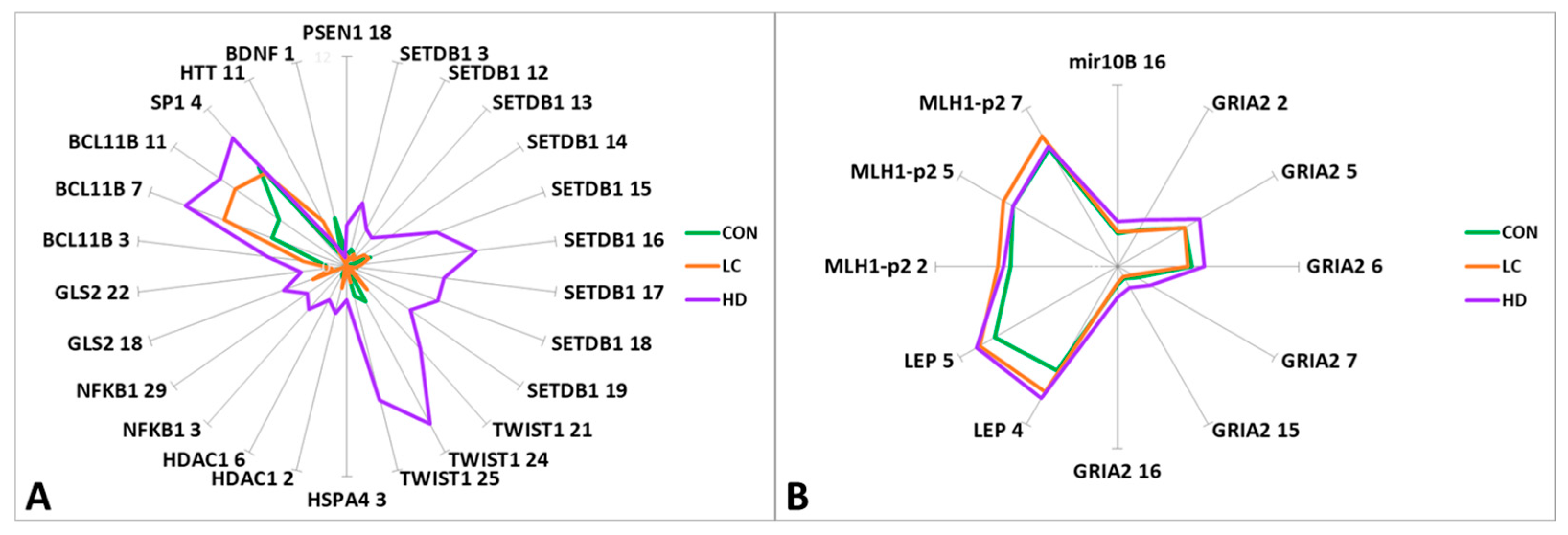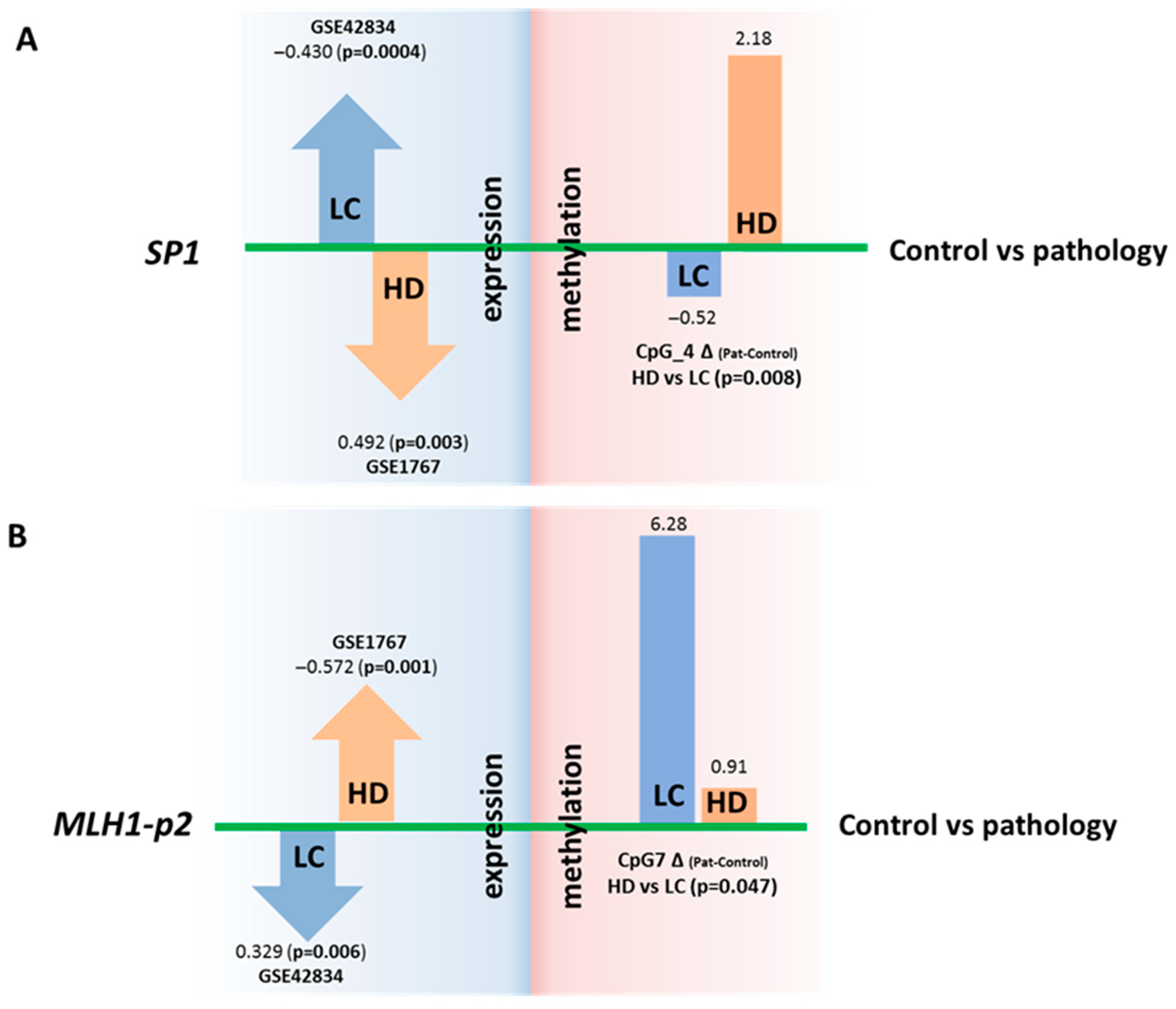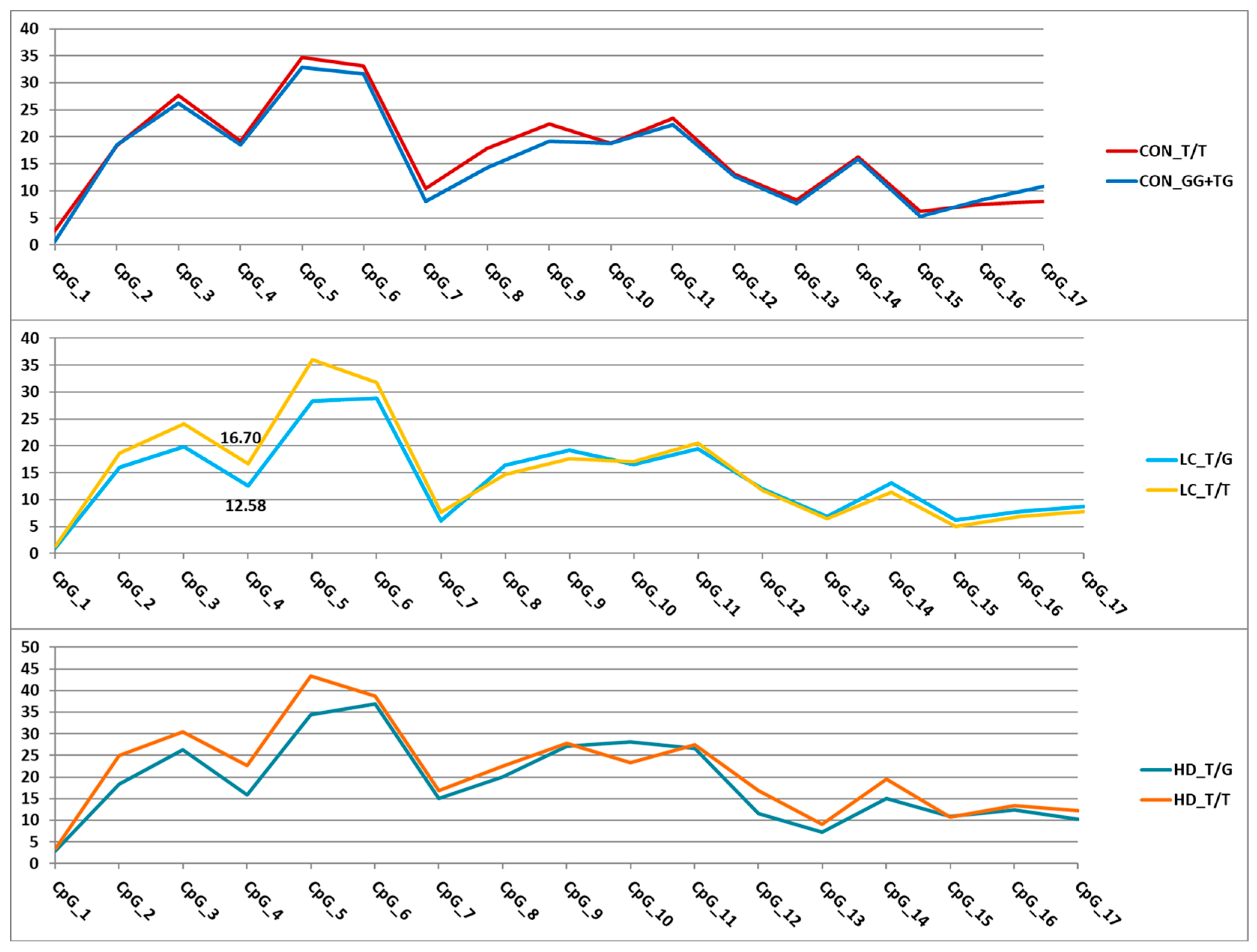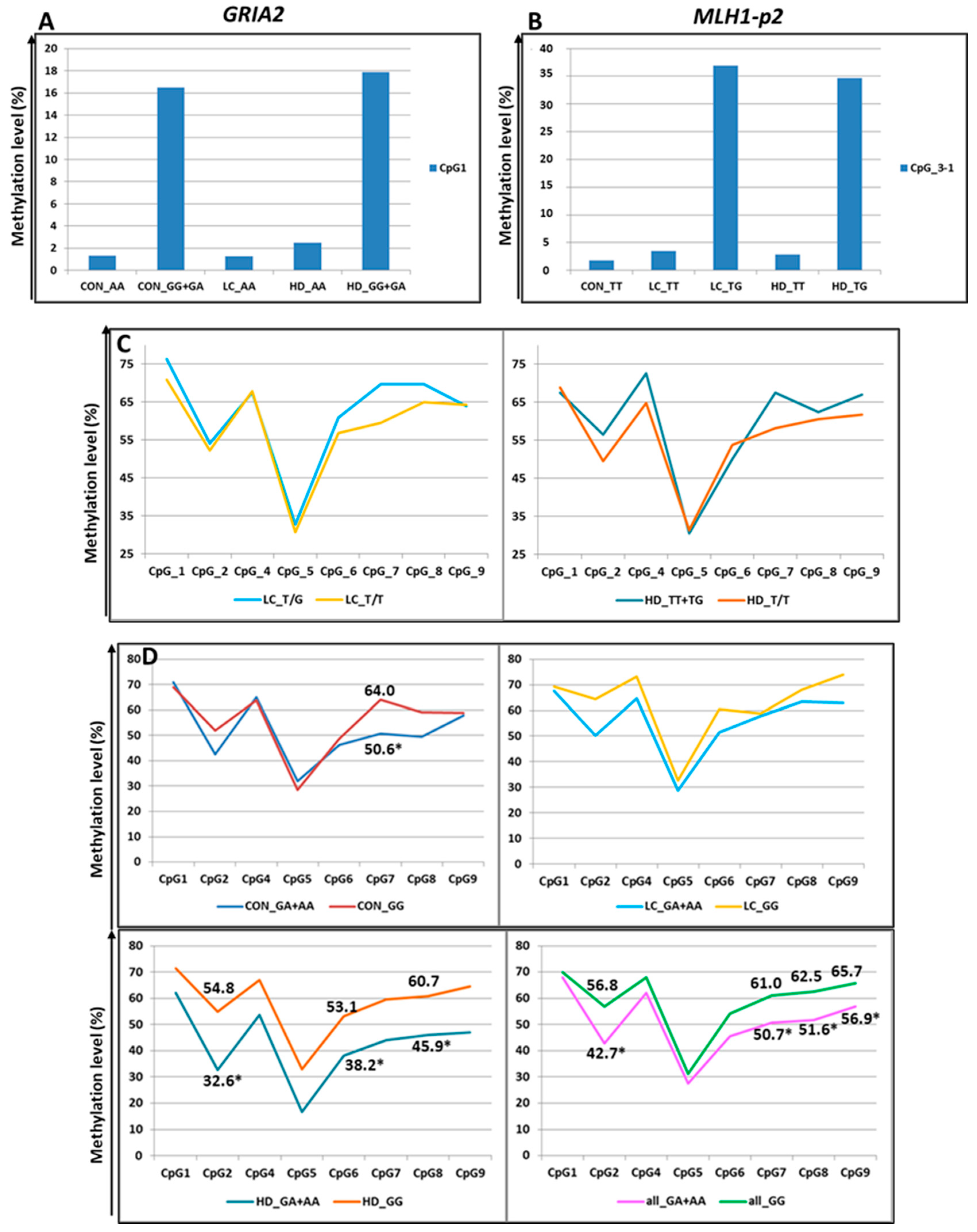DNA Methylation Status of Regulatory Regions of Apoptosis-Associated Genes in Dystropy «Huntington’s Disease—Non-Small Cell Lung Cancer»
Abstract
1. Introduction
2. Results
2.1. Characterization of Methylation Levels and Patterns at the Examined CpG Sites in Apoptosis-Associated Genes
2.1.1. Hypomethylated Genes
2.1.2. Genes Exhibiting Low Methylation Levels Across Most of the Analyzed Region
2.1.3. Genes Exhibiting Intermediate Methylation Levels in the Tested Region
2.1.4. A Hypermethylated Region
2.2. Comparison of Methylation Levels for CpG Sites in Apoptosis-Associated Genes in Blood Leukocytes Between the Groups
2.3. Functional Annotation of Regulatory Elements in the Studied Regions of Apoptosis-Associated Genes
2.3.1. Changes in the Expression of Apoptosis-Associated Genes in HD
2.3.2. Changes in Expression of Apoptosis-Associated Genes in LC
2.3.3. A Comparison of Expression Changes of Apoptosis-Associated Genes Between HD and LC
2.4. Interindividual Variation of DNA Methylation Levels
3. Discussion
- (1)
- Even within a single tissue type, the methylation levels of individual CpG sites varied substantially across different studies (Table S11).
- (2)
- This variability generally occurs in the same direction within the same tissue type. The correlation coefficient ranged from 0.47 to 0.95 in normal lung tissue and 0.50 to 0.99 in tumor lung tissue (Figure S2A,B), from 0.63 to 0.99 in PBMCs from HD patients, and was approximately 0.98 in healthy individuals (Figure S2C,D). The methylation levels in cell cultures (GSE147153: “Parental”, “Leaders”, and “Followers”) differed significantly from those in patient tissues.
- (3)
- While average methylation levels differ significantly between tissue types, the pattern of variability remains correlated in most cases. When comparing methylation in whole blood (our study) and lung tissue, the correlation coefficient ranged from 0.2 to 0.7 in cancer tissue and 0.1 to 0.9 in normal tissue (Figure S2A,B). Comparing methylation in the cortex and blood cells yielded correlation coefficients of 0.63–0.96 in HD patients and 0.59–0.97 in healthy individuals (Figure S2C,D).
- (4)
- The degree of correlation varied between genes, with the most stable values observed for the MLH1 gene, for which the largest number of CpG sites were compared.
4. Materials and Methods
4.1. The Studied Groups
4.2. The Genes Examined
4.3. The Analyzed Genomic Regions
4.4. The Experiments
4.5. Data Analysis
5. Conclusions
Supplementary Materials
Author Contributions
Funding
Institutional Review Board Statement
Informed Consent Statement
Data Availability Statement
Acknowledgments
Conflicts of Interest
Abbreviations
| HD | Huntington’s disease |
| LC | non–small cell lung cancer |
| CON | Control |
| CGIs | CpG islands |
| TSS | Transcription start site |
| TF | transcription factor |
| padj | p-value adjusted |
| SNP | single-nucleotide polymorphism |
| TPM | transcripts per million |
References
- Puzyrev, V.P. Genetic bases of human comorbidity. Russ. J. Genet. 2015, 51, 408–417. [Google Scholar] [CrossRef]
- Bragina, E.Y.; Puzyrev, V.P. Genetic outline of the hermeneutics of the diseases connection phenomenon in human. Vavilov J. Genet. Breed. 2023, 27, 297–305. [Google Scholar] [CrossRef]
- Catalá-López, F.; Suárez-Pinilla, M.; Suárez-Pinilla, P.; Valderas, J.M.; Gómez-Beneyto, M.; Martinez, S.; Balanzá-Martínez, V.; Climent, J.; Valencia, A.; McGrath, J.; et al. Inverse and direct cancer comorbidity in people with central nervous system disorders: A meta-analysis of cancer incidence in 577,013 participants of 50 observational studies. Psychother. Psychosom. 2014, 83, 89–105. [Google Scholar] [CrossRef]
- Forés-Martos, J.; Boullosa, C.; Rodrigo-Domínguez, D.; Sánchez-Valle, J.; Suay-García, B.; Climent, J.; Falcó, A.; Valencia, A.; Puig-Butillé, J.A.; Puig, S.; et al. Transcriptomic and Genetic Associations between Alzheimer’s Disease, Parkinson’s Disease, and Cancer. Cancers 2021, 13, 2990. [Google Scholar] [CrossRef] [PubMed]
- Pepe, P.; Vatrano, S.; Cannarella, R.; Calogero, A.E.; Marchese, G.; Ravo, M.; Fraggetta, F.; Pepe, L.; Pennisi, M.; Romano, C.; et al. A study of gene expression by RNA-seq in patients with prostate cancer and in patients with Parkinson disease: An example of inverse comorbidity. Mol. Biol. Rep. 2021, 48, 7627–7631. [Google Scholar] [CrossRef] [PubMed]
- Gomboeva, D.E.; Bragina, E.Y.; Nazarenko, M.S.; Puzyrev, V.P. The inverse comorbidity between oncological diseases and huntington’s disease: Review of epidemiological and biological evidence. Russ. J. Genet. 2020, 56, 269–279. [Google Scholar] [CrossRef]
- Online Catalog of Human Genes and Genetic Disorders (OMIM). Available online: https://www.omim.org (accessed on 10 January 2024).
- Rigamonti, D.; Bauer, J.H.; De-Fraja, C.; Conti, L.; Sipione, S.; Sciorati, C.; Clementi, E.; Hackam, A.; Hayden, M.R.; Li, Y.; et al. Wild-type huntingtin protects from apoptosis upstream of caspase-3. J. Neurosci. 2000, 20, 3705–3713. [Google Scholar] [CrossRef]
- Biswas, U.; Roy, R.; Ghosh, S.; Chakrabarti, G. The interplay between autophagy and apoptosis: Its implication in lung cancer and therapeutics. Cancer Lett. 2024, 585, 216662. [Google Scholar] [CrossRef]
- Bragina, E.Y.; Gomboeva, D.E.; Saik, O.V.; Ivanisenko, V.A.; Freidin, M.B.; Nazarenko, M.S.; Puzyrev, V.P. Apoptosis Genes as a Key to Identification of Inverse Comorbidity of Huntington’s Disease and Cancer. Int. J. Mol. Sci. 2023, 24, 9385. [Google Scholar] [CrossRef]
- Salameh, Y.; Bejaoui, Y.; El Hajj, N. DNA Methylation Biomarkers in Aging and Age-Related Diseases. Front. Genet. 2020, 11, 171. [Google Scholar] [CrossRef]
- Zsindely, N.; Siági, F.; Bodai, L. DNA Methylation in Huntington’s Disease. Int. J. Mol. Sci. 2021, 22, 12736. [Google Scholar] [CrossRef]
- Si, J.; Chen, L.; Yu, C.; Guo, Y.; Sun, D.; Pang, Y.; Millwood, I.Y.; Walters, R.G.; Yang, L.; Chen, Y.; et al. Healthy lifestyle, DNA methylation age acceleration, and incident risk of coronary heart disease. Clin. Epigenetics 2023, 15, 52. [Google Scholar] [CrossRef]
- Michaud, D.S.; Chung, M.; Zhao, N.; Koestler, D.C.; Lu, J.; Platz, E.A.; Kelsey, K.T. Epigenetic age and lung cancer risk in the CLUE II prospective cohort study. Aging 2023, 15, 617–629. [Google Scholar] [CrossRef] [PubMed]
- Yang, T.; Xiao, Y.; Cheng, Y.; Huang, J.; Wei, Q.; Li, C.; Shang, H. Epigenetic clocks in neurodegenerative diseases: A systematic review. J. Neurol. Neurosurg. Psychiatry 2023, 94, 1064–1070. [Google Scholar] [CrossRef]
- Eukaryotic Promotor Database (EPD). Available online: https://epd.expasy.org/epd (accessed on 20 January 2023).
- Jones, M.J.; Moore, S.R.; Kobor, M.S. Principles and Challenges of Applying Epigenetic Epidemiology to Psychology. Annu. Rev. Psychol. 2018, 69, 459–485. [Google Scholar] [CrossRef]
- Gao, X.; Jia, M.; Zhang, Y.; Breitling, L.P.; Brenner, H. DNA methylation changes of whole blood cells in response to active smoking exposure in adults: A systematic review of DNA methylation studies. Clin. Epigenet. 2015, 7, 113. [Google Scholar] [CrossRef]
- Joubert, B.R.; Felix, J.F.; Yousefi, P.; Bakulski, K.M.; Just, A.C.; Breton, C.; Reese, S.E.; Markunas, C.A.; Richmond, R.C.; Xu, C.J.; et al. DNA Methylation in Newborns and Maternal Smoking in Pregnancy: Genome-wide Consortium Meta-analysis. Am. J. Hum. Genet. 2016, 98, 680–696. [Google Scholar] [CrossRef]
- Breton, C.V.; Marsit, C.J.; Faustman, E.; Nadeau, K.; Goodrich, J.M.; Dolinoy, D.C.; Herbstman, J.; Holland, N.; LaSalle, J.M.; Schmidt, R.; et al. Small-Magnitude Effect Sizes in Epigenetic End Points are Important in Children’s Environmental Health Studies: The Children’s Environmental Health and Disease Prevention Research Center’s Epigenetics Working Group. Environ. Health Perspect. 2017, 125, 511–526. [Google Scholar] [CrossRef]
- Polli, A.; Hendrix, J.; Ickmans, K.; Bakusic, J.; Ghosh, M.; Monteyne, D.; Velkeniers, B.; Bekaert, B.; Nijs, J.; Godderis, L. Genetic and epigenetic regulation of Catechol-O-methyltransferase in relation to inflammation in chronic fatigue syndrome and Fibromyalgia. J. Transl. Med. 2022, 20, 487. [Google Scholar] [CrossRef] [PubMed]
- UCSC Genome Browser. Available online: https://genome.ucsc.edu (accessed on 15 March 2024).
- Lesurf, R.; Cotto, K.C.; Wang, G.; Griffith, M.; Kasaian, K.; Jones, S.J.; Montgomery, S.B.; Griffith, O.L.; Open Regulatory Annotation Consortium. ORegAnno 3.0: A community-driven resource for curated regulatory annotation. Nucleic Acids Res. 2016, 44, D126–D132. [Google Scholar] [CrossRef] [PubMed]
- ENCODE. Available online: https://www.encodeproject.org/ (accessed on 2 March 2024).
- ENCODE Project Consortium; Moore, J.E.; Purcaro, M.J.; Pratt, H.E.; Epstein, C.B.; Shoresh, N.; Adrian, J.; Kawli, T.; Davis, C.A.; Dobin, A.; et al. Expanded encyclopaedias of DNA elements in the human and mouse genomes. Nature 2020, 583, 699–710. [Google Scholar] [CrossRef] [PubMed]
- Shen, W.; Xu, C.; Huang, W.; Zhang, J.; Carlson, J.E.; Tu, X.; Wu, J.; Shi, Y. Solution structure of human Brg1 bromodomain and its specific binding to acetylated histone tails. Biochemistry 2007, 46, 2100–2110. [Google Scholar] [CrossRef]
- Zandarashvili, L.; White, M.A.; Esadze, A.; Iwahara, J. Structural impact of complete CpG methylation within target DNA on specific complex formation of the inducible transcription factor Egr-1. FEBS Lett. 2015, 589, 1748–1753. [Google Scholar] [CrossRef]
- Samra, N.; Toubiana, S.; Yttervik, H.; Tzur-Gilat, A.; Morani, I.; Itzkovich, C.; Giladi, L.; Abu Jabal, K.; Cao, J.Z.; Godley, L.A.; et al. RBL2 bi-allelic truncating variants cause severe motor and cognitive impairment without evidence for abnormalities in DNA methylation or telomeric function. J. Hum. Genet. 2021, 66, 1101–1112. [Google Scholar] [CrossRef]
- Singal, R.; Ginder, G.D. DNA methylation. Blood 1999, 93, 4059–4070. [Google Scholar] [CrossRef] [PubMed]
- Woodfield, G.W.; Hitchler, M.J.; Chen, Y.; Domann, F.E.; Weigel, R.J. Interaction of TFAP2C with the estrogen receptor-α promoter is controlled by chromatin structure. Clin. Cancer Res. 2009, 15, 3672–3679. [Google Scholar] [CrossRef]
- Jeong, K.W.; Andreu-Vieyra, C.; You, J.S.; Jones, P.A.; Stallcup, M.R. Establishment of active chromatin structure at enhancer elements by mixed-lineage leukemia 1 to initiate estrogen-dependent gene expression. Nucleic Acids Res. 2014, 42, 2245–2256. [Google Scholar] [CrossRef]
- Le Berre, G.; Hossard, V.; Riou, J.F.; Guieysse-Peugeot, A.L. Repression of TERRA Expression by Subtelomeric DNA Methylation Is Dependent on NRF1 Binding. Int. J. Mol. Sci. 2019, 20, 2791. [Google Scholar] [CrossRef]
- Pepin, M.E.; Infante, T.; Benincasa, G.; Schiano, C.; Miceli, M.; Ceccarelli, S.; Megiorni, F.; Anastasiadou, E.; Della Valle, G.; Fatone, G.; et al. Differential DNA Methylation Encodes Proliferation and Senescence Programs in Human Adipose-Derived Mesenchymal Stem Cells. Front. Genet. 2020, 11, 346. [Google Scholar] [CrossRef] [PubMed]
- Aure, M.R.; Fleischer, T.; Bjørklund, S.; Ankill, J.; Castro-Mondragon, J.A.; OSBREAC; Børresen-Dale, A.L.; Tost, J.; Sahlberg, K.K.; Mathelier, A.; et al. Crosstalk between microRNA expression and DNA methylation drives the hormone-dependent phenotype of breast cancer. Genome Med. 2021, 13, 72. [Google Scholar] [CrossRef] [PubMed]
- Tian, G.; He, L.; Gu, R.; Sun, J.; Chen, W.; Qian, Y.; Ma, X.; Yan, W.; Zhao, Z.; Xu, Z.; et al. CpG site hypomethylation at ETS1-binding region regulates DLK1 expression in Chinese patients with Tetralogy of Fallot. Mol. Med. Rep. 2022, 25, 93. [Google Scholar] [CrossRef]
- Kulak, M.V.; Cyr, A.R.; Woodfield, G.W.; Bogachek, M.; Spanheimer, P.M.; Li, T.; Price, D.H.; Domann, F.E.; Weigel, R.J. Transcriptional regulation of the GPX1 gene by TFAP2C and aberrant CpG methylation in human breast cancer. Oncogene 2013, 32, 4043–4051. [Google Scholar] [CrossRef]
- Gustems, M.; Woellmer, A.; Rothbauer, U.; Eck, S.H.; Wieland, T.; Lutter, D.; Hammerschmidt, W. c-Jun/c-Fos heterodimers regulate cellular genes via a newly identified class of methylated DNA sequence motifs. Nucleic Acids Res. 2014, 42, 3059–3072. [Google Scholar] [CrossRef] [PubMed]
- Razin, A. CpG methylation, chromatin structure and gene silencing—A three-way connection. EMBO J. 1998, 17, 4905–4908. [Google Scholar] [CrossRef] [PubMed]
- Genotype-Tissue Expression (GTEx) Portal. Available online: https://www.gtexportal.org/home (accessed on 17 January 2024).
- Deng, G.; Chen, A.; Pong, E.; Kim, Y.S. Methylation in hMLH1 promoter interferes with its binding to transcription factor CBF and inhibits gene expression. Oncogene 2001, 20, 7120–7127. [Google Scholar] [CrossRef]
- Benhamida, J.K.; Hechtman, J.F.; Nafa, K.; Villafania, L.; Sadowska, J.; Wang, J.; Wong, D.; Zehir, A.; Zhang, L.; Bale, T.; et al. Reliable Clinical MLH1 Promoter Hypermethylation Assessment Using a High-Throughput Genome-Wide Methylation Array Platform. J. Mol. Diagn. 2020, 22, 368–375. [Google Scholar] [CrossRef]
- Feinberg, A.P.; Irizarry, R.A. Evolution in health and medicine Sackler colloquium: Stochastic epigenetic variation as a driving force of development, evolutionary adaptation, and disease. Proc. Natl. Acad. Sci. USA 2010, 107, 1757–1764. [Google Scholar] [CrossRef]
- Grundberg, E.; Meduri, E.; Sandling, J.K.; Hedman, A.K.; Keildson, S.; Buil, A.; Busche, S.; Yuan, W.; Nisbet, J.; Sekowska, M. Global analysis of DNA methylation variation in adipose tissue from twins reveals links to disease-associated variants in distal regulatory elements. Am. J. Hum. Genet. 2013, 93, 876–890. [Google Scholar] [CrossRef]
- Ahsan, M.; Ek, W.E.; Rask-Andersen, M.; Karlsson, T.; Lind-Thomsen, A.; Enroth, S.; Gyllensten, U.; Johansson, Å. The relative contribution of DNA methylation and genetic variants on protein biomarkers for human diseases. PLoS Genet. 2017, 13, e1007005. [Google Scholar] [CrossRef] [PubMed]
- Yu, C.E.; Foraker, J. Epigenetic considerations of the APOE gene. Biomol. Concepts 2015, 6, 77–84. [Google Scholar] [CrossRef]
- Foraker, J.; Millard, S.P.; Leong, L.; Thomson, Z.; Chen, S.; Keene, C.D.; Bekris, L.M.; Yu, C.E. The APOE Gene is Differentially Methylated in Alzheimer’s Disease. J. Alzheimer’s Dis. 2015, 48, 745–755. [Google Scholar] [CrossRef]
- Yu, C.; Tulloch, J.; Chen, S.; Leong, L.; Todd, K.; Millard, S.; Lee, E. APOE RNA production is modulated by dna methylation near ε2/ε3/ε4 defining SNPs. Alzheimer’s Dement. J. 2019, 15, P1308–P1309. [Google Scholar] [CrossRef]
- Babushkina, N.P.; Zarubin, A.A.; Koroleva, I.A.; Gomboeva, D.E.; Bragina, E.Y.; Goncharova, I.A.; Golubenko, M.V.; Salakhov, R.R.; Sleptcov, A.A.; Kuznetsov, M.S.; et al. Methylation of Regulatory Regions of DNA Repair Genes in Carotid Atherosclerosis. Mol. Biol. 2023, 57, 637–652. [Google Scholar] [CrossRef]
- Bečanović, K.; Nørremølle, A.; Neal, S.J.; Kay, C.; Collins, J.A.; Arenillas, D.; Lilja, T.; Gaudenzi, G.; Manoharan, S.; Doty, C.N.; et al. A SNP in the HTT promoter alters NF-κB binding and is a bidirectional genetic modifier of Huntington disease. Nat. Neurosci. 2015, 18, 807–816. [Google Scholar] [CrossRef]
- Zhu, H.; Li, X.; Zhang, X.; Chen, D.; Li, D.; Ren, J.; Gu, H.; Shu, Y.; Wang, D. Polymorphisms in mismatch repair genes are associated with risk and microsatellite instability of gastric cancer, and interact with life exposures. Gene 2016, 579, 52–57. [Google Scholar] [CrossRef]
- Savio, A.J.; Bapat, B. Modulation of transcription factor binding and epigenetic regulation of the MLH1 CpG island and shore by polymorphism rs1800734 in colorectal cancer. Epigenetics 2017, 12, 441–448. [Google Scholar] [CrossRef] [PubMed]
- Zhu, X.; Liu, W.; Qiu, X.; Wang, Z.; Tan, C.; Bei, C.; Qin, L.; Ren, Y.; Tan, S. Single nucleotide polymorphisms in MLH1 predict poor prognosis of hepatocellular carcinoma in a Chinese population. Oncotarget 2017, 8, 80039–80049. [Google Scholar] [CrossRef] [PubMed]
- Thomas, R.; Trapani, D.; Goodyer-Sait, L.; Tomkova, M.; Fernandez-Rozadilla, C.; Sahnane, N.; Woolley, C.; Davis, H.; Chegwidden, L.; Kriaucionis, S.; et al. The polymorphic variant rs1800734 influences methylation acquisition and allele-specific TFAP4 binding in the MLH1 promoter leading to differential mRNA expression. Sci. Rep. 2019, 9, 13463. [Google Scholar] [CrossRef] [PubMed]
- Pongsavee, M.; Wisuwan, K.; Pongsavee, K. MLH1 rs1800734 Pathogenic Variant among Patients with Colorectal Cancer in the Lower Northeastern Region of Thailand. Asian Pac. J. Cancer Prev. 2023, 24, 2911–2916. [Google Scholar] [CrossRef]
- Savio, A.J.; Lemire, M.; Mrkonjic, M.; Gallinger, S.; Zanke, B.W.; Hudson, T.J.; Bapat, B. MLH1 region polymorphisms show a significant association with CpG island shore methylation in a large cohort of healthy individuals. PLoS ONE 2012, 7, e51531. [Google Scholar] [CrossRef] [PubMed]
- Wang, R.; Luo, Y.; Ly, P.T.; Cai, F.; Zhou, W.; Zou, H.; Song, W. Sp1 regulates human huntingtin gene expression. J. Mol. Neurosci. 2012, 47, 311–321. [Google Scholar] [CrossRef]
- Dunah, A.W.; Jeong, H.; Griffin, A.; Kim, Y.M.; Standaert, D.G.; Hersch, S.M.; Mouradian, M.M.; Young, A.B.; Tanese, N.; Krainc, D. Sp1 and TAFII130 transcriptional activity disrupted in early Huntington’s disease. Science 2002, 296, 2238–2243. [Google Scholar] [CrossRef]
- Wierstra, I. Sp1: Emerging roles—Beyond constitutive activation of TATA-less housekeeping genes. Biochem. Biophys. Res. Commun. 2008, 372, 1–13. [Google Scholar] [CrossRef]
- Chen-Plotkin, A.S.; Sadri-Vakili, G.; Yohrling, G.J.; Braveman, M.W.; Benn, C.L.; Glajch, K.E.; DiRocco, D.P.; Farrell, L.A.; Krainc, D.; Gines, S.; et al. Decreased association of the transcription factor Sp1 with genes downregulated in Huntington’s disease. Neurobiol. Dis. 2006, 22, 233–241. [Google Scholar] [CrossRef]
- Seredenina, T.; Luthi-Carter, R. What have we learned from gene expression profiles in Huntington’s disease? Neurobiol. Dis. 2012, 45, 83–98. [Google Scholar] [CrossRef]
- Conforti, P.; Besusso, D.; Brocchetti, S.; Campus, I.; Cappadona, C.; Galimberti, M.; Laporta, A.; Iennaco, R.; Rossi, R.L.; Dickinson, V.B.; et al. RUES2 hESCs exhibit MGE-biased neuronal differentiation and muHTT-dependent defective specification hinting at SP1. Neurobiol. Dis. 2020, 146, 105140. [Google Scholar] [CrossRef]
- Hsu, T.I.; Wang, M.C.; Chen, S.Y.; Yeh, Y.M.; Su, W.C.; Chang, W.C.; Hung, J.J. Sp1 expression regulates lung tumor progression. Oncogene 2012, 31, 3973–3988. [Google Scholar] [CrossRef] [PubMed]
- Sambrook, J.; Russell, D.W. Purification of nucleic acids by extraction with phenol:chloroform. CSH Protoc. 2006, 2006, pdb.prot4455. [Google Scholar] [CrossRef] [PubMed]
- Masser, D.R.; Stanford, D.R.; Freeman, W.M. Targeted DNA methylation analysis by next-generation sequencing. J. Vis. Exp. 2015, 96, 52488. [Google Scholar] [CrossRef]







Disclaimer/Publisher’s Note: The statements, opinions and data contained in all publications are solely those of the individual author(s) and contributor(s) and not of MDPI and/or the editor(s). MDPI and/or the editor(s) disclaim responsibility for any injury to people or property resulting from any ideas, methods, instructions or products referred to in the content. |
© 2025 by the authors. Licensee MDPI, Basel, Switzerland. This article is an open access article distributed under the terms and conditions of the Creative Commons Attribution (CC BY) license (https://creativecommons.org/licenses/by/4.0/).
Share and Cite
Babushkina, N.P.; Bragina, E.Y.; Gomboeva, D.E.; Koroleva, I.A.; Illarioshkin, S.N.; Klyushnikov, S.A.; Abramycheva, N.Y.; Nikitina, M.A.; Alifirova, V.M.; Litviakov, N.V.; et al. DNA Methylation Status of Regulatory Regions of Apoptosis-Associated Genes in Dystropy «Huntington’s Disease—Non-Small Cell Lung Cancer». Epigenomes 2025, 9, 28. https://doi.org/10.3390/epigenomes9030028
Babushkina NP, Bragina EY, Gomboeva DE, Koroleva IA, Illarioshkin SN, Klyushnikov SA, Abramycheva NY, Nikitina MA, Alifirova VM, Litviakov NV, et al. DNA Methylation Status of Regulatory Regions of Apoptosis-Associated Genes in Dystropy «Huntington’s Disease—Non-Small Cell Lung Cancer». Epigenomes. 2025; 9(3):28. https://doi.org/10.3390/epigenomes9030028
Chicago/Turabian StyleBabushkina, Nadezhda P., Elena Yu. Bragina, Densema E. Gomboeva, Iuliia A. Koroleva, Sergey N. Illarioshkin, Sergey A. Klyushnikov, Nataliya Yu. Abramycheva, Maria A. Nikitina, Valentina M. Alifirova, Nikolai V. Litviakov, and et al. 2025. "DNA Methylation Status of Regulatory Regions of Apoptosis-Associated Genes in Dystropy «Huntington’s Disease—Non-Small Cell Lung Cancer»" Epigenomes 9, no. 3: 28. https://doi.org/10.3390/epigenomes9030028
APA StyleBabushkina, N. P., Bragina, E. Y., Gomboeva, D. E., Koroleva, I. A., Illarioshkin, S. N., Klyushnikov, S. A., Abramycheva, N. Y., Nikitina, M. A., Alifirova, V. M., Litviakov, N. V., Ibragimova, M. K., Tsyganov, M. M., Tsydenova, I. A., Zarubin, A. A., Goncharova, I. A., Golubenko, M. V., Salakhov, R. R., Sleptcov, A. A., Kucher, A. N., ... Puzyrev, V. P. (2025). DNA Methylation Status of Regulatory Regions of Apoptosis-Associated Genes in Dystropy «Huntington’s Disease—Non-Small Cell Lung Cancer». Epigenomes, 9(3), 28. https://doi.org/10.3390/epigenomes9030028







